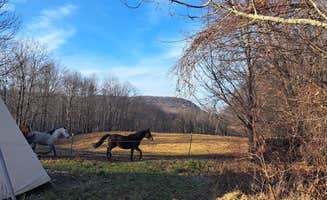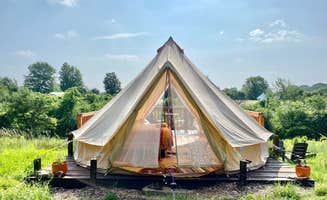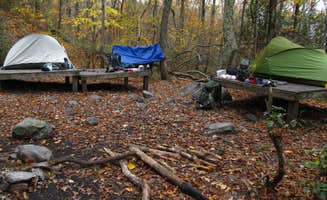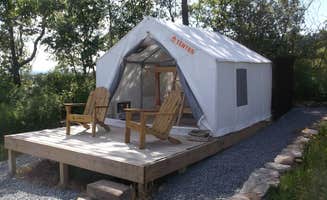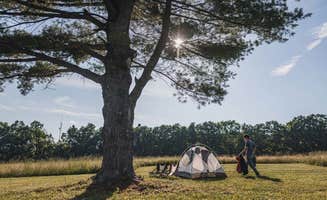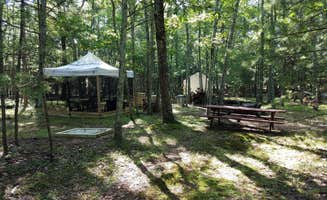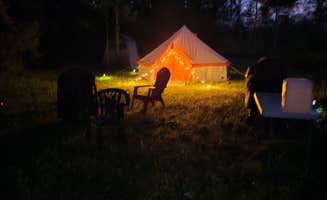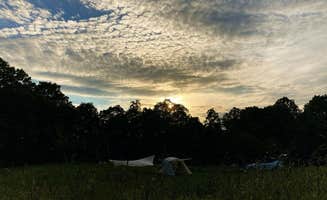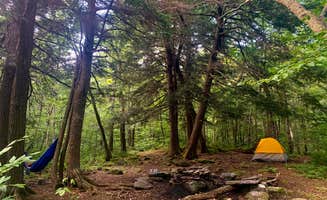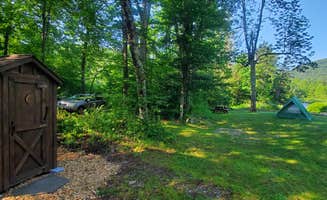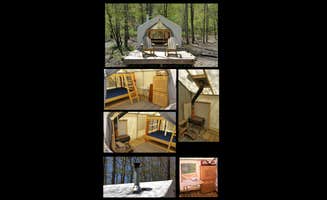Dispersed tent camping near Coeymans, New York offers wilderness experiences amid the varied terrain of the Catskills region. The area features elevations ranging from 300 to 3,500 feet, creating microclimates that affect camping conditions throughout the seasons. Spring camping often requires preparation for wet conditions with nighttime temperatures frequently dropping below 40°F even when daytime temperatures reach the 70s.
What to do
Hiking to campsite views: Reaching Giant Ledge Primitive Camp requires effort but rewards campers with exceptional vistas. "It take the average hiker about an hour ish to get to camp/ledge view. This one is one of my favs," notes Ryan. The trail involves significant elevation gain with challenging terrain, as Caleb J. explains: "It is a near vertical hike the first mile with 90% or more being over rock gardens... It doesn't wind it's way up the mountain, someone picked a side and said 'we go up from here, straight up.'"
Water access options: Many campsites provide stream or pond access for filtration but no developed water sources. John S. from Giant Ledge Primitive Camp mentions "The spring water source is a short hike back from the campsite, relatively convenient to restock from camp." Pack water treatment systems when camping in these areas as potable water isn't available at most primitive sites.
Wildlife observation: Bears are common throughout dispersed camping areas. Proper precautions are essential when visiting Brassie Brook Shelter. One camper shares: "There's also a bear box near by. Room to camp your tent on the ground too if you wanted to or had more ppl along." Bring bear bells and proper food storage containers when tent camping in this region.
What campers like
Uncrowded camping experience: Primitive campsites often provide solitude unavailable at developed campgrounds. At Alander Trail Campground, Kay D. notes: "It's completely free and it usually isn't too busy since most people don't like having to carry all their stuff in that far." Sites require effort to reach but reward with privacy.
Star visibility: Clear night skies away from light pollution offer impressive celestial views at higher elevations. Ryan describes Giant Ledge Primitive Camp: "Yes you can star gaze by the views near the camp. Yes it's amazing." Campers frequently mention astronomical viewing as a highlight of overnight stays.
Well-maintained primitive sites: Despite difficult access roads, Duck Pond Campsite features surprisingly good campsite conditions. Yae U. reports: "After driving unpaved dirt road for a while, we arrived a surprisingly well maintained beautiful campsites. The pond is small so the mosquitos were not too bad." Many primitive sites include established fire rings despite minimal other infrastructure.
What you should know
Access challenges: Many roads to dispersed camping areas require high-clearance vehicles. The L. cautions about Duck Pond Campsite: "The road in on old cemetery rd was pretty rough, so we decided to go out the other way, which was way worse... Intermittent cell service which was frightening while driving on these rough roads." Plan travel routes carefully and consider downloading offline maps.
Campsite availability fluctuates: Designated primitive sites fill quickly during peak seasons (September-October and June-August). The limited number of established spots at each location means early arrival increases chances of securing a site, especially at popular locations like Giant Ledge where Tina D. notes: "Getting a campsite up at the Giant Ledge area is hit or miss, as I only know of two."
Weather preparation: Laurel Ridge campsites experience rapid temperature changes requiring versatile gear. Tina D. reports: "There was a fire pit there so we used it at night because it was pretty cold in the 50s and down to 40s late at night (this was OCT)." Pack layers regardless of season as mountain elevations create unpredictable conditions.
Tips for camping with families
Starter backpacking experiences: For families new to wilderness camping, seek established sites with some amenities. Kate from Echo Lake shares: "This campground was my first backpacking trip and it was perfect! There are tent sites around the whole lake with fire pits and 1 lean-to site at the end of the trail when you first arrive at the lake."
Wildlife education opportunities: Use primitive camping as a learning experience about local ecosystems. Teach children proper food storage techniques and wildlife awareness. John S. from Giant Ledge notes: "Thought I heard bears come through overnight, but may have been a lucid dream. Bear can was undisturbed in the morning."
Trail difficulty assessment: Carefully research trail conditions before bringing children on backcountry camping trips. Many trails to primitive sites involve challenging terrain. Nora S. describes Brassie Brook Shelter access: "We started our hike at the under-mountain trailhead, located right off route 41, and climbed up the mountain. Be prepared for steep inclines, and lots of rocks."
Tips from RVers
Parking limitations: Most dispersed camping areas near Coeymans prohibit direct RV access. When visiting Ushers Road State Forest, The L. notes: "Given that camping is permitted anywhere in the woods as long as it's at least 150 feet off the trail, the surrounding area offers an abundance of potential camping spots." RVers must often park at trailheads and backpack to tent sites.
Alternative nearby options: When primitive sites prove inaccessible, consider established campgrounds that accommodate vehicles. Tina D. advises: "If that's the case, there is a normal campsite called Woodlands nearby that has a ton of sites and RV sites." Research options within 30-45 minute drives of planned dispersed camping locations.



